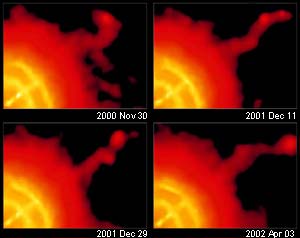This area deals with the fundamental laws and building blocks of nature and how they interact, the properties and the behavior of matter, and research into space and time and their structures.
innovations-report provides in-depth reports and articles on subjects such as astrophysics, laser technologies, nuclear, quantum, particle and solid-state physics, nanotechnologies, planetary research and findings (Mars, Venus) and developments related to the Hubble Telescope.

Achievement Could Improve Understanding of Superconductivity
A team of researchers at JILA, a joint institute of the Commerce Department’s National Institute of Standards and Technology (NIST) and the University of Colorado at Boulder, has done the physics equivalent of efficiently turning yin into yang. They changed individual potassium atoms belonging to a class of particles called fermions into molecules that are part of a fundamentally different class of particles known as bosons

NASA-funded researchers recently obtained the first complete proof of a 50-year-old hypothesis explaining how liquid metals resist turning into solids
The research is featured on the cover of the July issue of Physics Today. It challenges theories about how crystals form by a process called nucleation, important in everything from materials to biological systems.
“Nucleation is everywhere,” said Dr. Kenneth Kelton, the physics professor who leads a research team from Washing

ESA’s Mars Express spacecraft is progressing further every day on its journey to the Red Planet. Everything is set for arrival at Mars on the night of 25 December 2003, after a journey of about 400 million kilometres. In the weeks since its launch, engineers have started to thoroughly test the spacecraft and its equipment.
This testing phase is standard for all spacecraft on the way to their destination. Known as commissioning, it began 3 weeks after the launch. During this time, ground cont

An X-ray movie of the Vela pulsar, made from a series of observations by NASA’s Chandra X-ray Observatory, reveals a spectacularly erratic jet that varies in a way never seen before. The jet of high-energy particles whips about like an untended firehose at about half the speed of light. This behavior gives scientists new insight into the nature of jets from pulsars and black holes.
Chandra observed the Vela pulsar, a rotating neutron star, 13 times between January 2000 and August 2002. The

Gemini Observatory’s new spectrograph, without the help of adaptive optics, recently captured images that are among the sharpest ever obtained of astronomical objects from the ground.
Along with the images and spectra acquired during recent commissioning of the Gemini Multi-Object Spectrograph (GMOS) on the 8-metre Gemini South Telescope in Chile, one image is particularly compelling. This Gemini image reveals remarkable details, previously only seen from space, of the Hickson C

This innovative instrument is aimed to hunt the elusive gravitational waves using extremely sophisticated technological solutions.
On July 23rd in Cascina, near Pisa (Italy), the new Virgo interferometer will be inaugurated. The innovative Virgo gravitational-wave-detector is the outcome of more than ten years of collaborative research and development between the National Institute of Nuclear Physics (Infn, Italy) and the National Scientific Research Centre (Cnrs, France). Letizia Mor